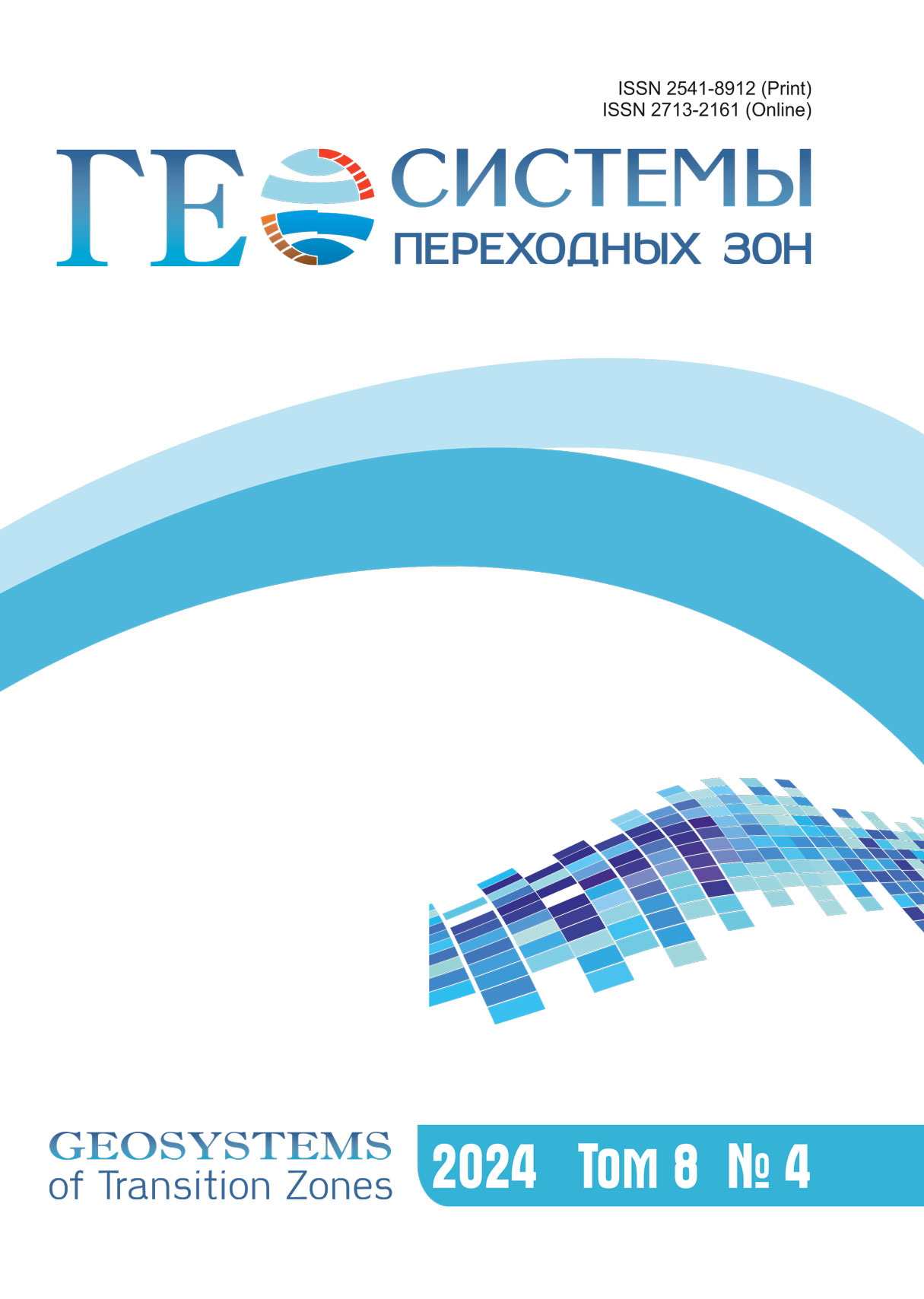
| Abstract PDF ENG. .PDF RUS | Full text PDF ENG. .PDF ENG |
Abstract. The paper proposes a method for anomaly detection in geomagnetic data based on the classical autoencoder architecture. The training data consisted of daily variations in the geomagnetic field on quiet days for 2020, 2021, and 2022, collected from the Ak-Suu base station of the geomagnetic monitoring network of the Research Station of the Russian Academy of Sciences in Bishkek. The neural network has five hidden layers with a total of ≈3.5·106 trainable parameters. The trained model accurately reproduces typical features of normal data, whereas in the presence of anomalies it shows a decline in reconstruction quality. This property of the autoencoder was used to classify the data into two categories: normal and anomalous. The reconstruction error, measured as the Mean Absolute Error (MAE), was used as the anomaly metric. In particular, the MAE value of 0.109 was used as the threshold for class separation. Testing the model on the data from the Ak-Suu station for 2017, 2018, and 2019 demonstrated good results. Binary classification metrics such as recall and F1-score were notably high: 0.965 and 0.918 for the 2017 data, 0.982 and 0.933 for the 2018 data, and 0.970 and 0.935 for the 2019 data, respectively.
Keywords:
anomaly, geomagnetic field, variational series, neural network, autoencoder, confusion matrix
For citation: Imashev S.A. Method for detecting anomalies in geomagnetic field variations based on artificial neural network. Geosistemy perehodnykh zon = Geosystems of Transition Zones, 2024, vol. 8, No. 4, pp. 343–356.
https://doi.org/10.30730/gtrz.2024.8.4.343-356, https://www.elibrary.ru/fhzskv
Для цитирования: Имашев С.А. Методика обнаружения аномалий в вариациях величины геомагнитного поля на основе искусственной нейронной сети [Электронный ресурс]. Геосистемы переходных зон, 2024, т. 8, № 4. 14 с.
http://journal.imgg.ru/web/full/f2024-4-6.pdf, https://doi.org/10.30730/gtrz.2024.8.4.343-356
References
1. Mukhamadeeva V.А., Vorontsova E.V., Lazareva E.A. 2015. Experience of geomagnetic observations at the geodynamic test ground in Bishkek. Vestnik of KRSU = Herald of KRSU, 15(3): 130–133.
2. Campbell W.H. 2003. Introduction to Geomagnetic Fields. Cambridge Univ. Press, 337 p. https://doi.org/10.1017/cbo9781139165136
3. Hawkins D.M. 1980 . Identification of outliers. Springer, 188 p. https://doi.org/10.1007/978-94-015-3994-4
4. Chandola V., Banerjee A., Kumar V. 2009. Anomaly detection: A survey. ACM Computing Surveys, 41(3): 1–58. https://doi.org/10.1145/1541880.1541882
5. Pang G., Shen C., Cao L., Hengel A. 2020. Deep learning for anomaly detection: A review. ACM Computing Surveys, 54(2): 1–38. https://doi.org/10.1145/3439950
6. Goodfellow I., Bengio Y., Courville A. 2016. Deep learning. MIT Press, 800 p.
7. Yildirim O., Tan R.S., Rajendra Acharya U. 2018. An efficient compression of ECG signals using deep convolutional autoencoders. Cognitive Systems Research, 52: 198–211. https://doi.org/10.1016/j.cogsys.2018.07.004
8. Marchi E., Vesperini F., Squartini S., Schuller B. 2017. Deep recurrent neural network-based autoencoders for acoustic novelty detection. Computational Intelligence and Neuroscience, 1(4694860). 14 p. https://doi.org/10.1155/2017/4694860
9. Valentin M.B., Bom C.R., Martins Compan A.L., Correia M.D., Menezes de Jesus C., de Lima Souza, de Albuquerque Marcio P., de Albuquerque Marcelo P., Faria E.L. 2018. Estimation of permeability and effective porosity logs using deep autoencoders in borehole image logs from the brazilian pre-salt carbonate. Journal of Petroleum Science and Engineering, 170: 315–330. https://doi.org/10.1016/j.petrol.2018.06.038
10. Fraiwan L., Lweesy K. 2017. Neonatal sleep state identification using deep learning autoencoders. 2017 IEEE 13th International Colloquium on Signal Processing & Its Applications (CSPA), Penang, Malaysia. https://doi.org/10.1109/cspa.2017.8064956
11. Wang L., Zhang Z., Xu J., Liu R. 2018 . Wind turbine blade breakage monitoring with deep autoencoders. IEEE Transactions on Smart Grid, 9(4): 2824–2833. https://doi.org/10.1109/tsg.2016.2621135
12. Pal A., Baskar S. 2015. Speech emotion recognition using deep dropout autoencoders. 2015 IEEE International Conference on Engineering and Technology, Penang, Malaysia. https://doi.org/10.1109/icetech.2015.7275003
13. Gao S., Zhang Y., Jia K., Lu J., Zhang Y. 2015. Single sample face recognition via learning deep supervised autoencoders. IEEE Transactions on Information Forensics and Security, 10(10): 2108–2118. https://doi.org/10.1109/tifs.2015.2446438
14. Gomes T.A., Carvalho R.N., Carvalho R.S. 2017. Identifying anomalies in parliamentary expenditures of Brazilian chamber of deputies with deep autoencoders. 2017 16th IEEE International Conference on Machine Learning and Applications, Cancun, Mexico. https://doi.org/10.1109/icmla.2017.00-33
15. Imashev S.A., Rybin A.K. 2023. Seismic and geoacoustic responses of the Earth’s crust to sensing with high energy electric pulses at the territory of the Bishkek geodynamic polygon. Science and technological developments, 102(2-3): 63–88. https://doi.org/10.21455/std2023.2-3-3
16. Chen S., Meng Z., Zhao Q. 2018. Electrocardiogram recognization based on variational autoencoder. Machine Learning and Biometrics. https://doi.org/10.5772/intechopen.76434
17. Sakurada M., Yairi T. 2014. Anomaly detection using autoencoders with nonlinear dimensionality reduction. Proceedings of the MLSDA 2014 2nd Workshop on Machine Learning for Sensory Data Analysis . https://doi.org/10.1145/2689746.2689747
18. Bishop C.M., Bishop H. 2024. Deep learning: Foundations and concepts. Cham: Springer Intern. Publ., 649 p. https://doi.org/10.1007/978-3-031-45468-4
19. Imashev S.A. 2021. Extended isolation forest – Application to outlier detection in geomagnetic data. IOP Conference Series: Earth and Environmental Science , 929, 012022. https://doi.org/10.1088/1755-1315/929/1/012022
20. Nair V., Hinton G.E. 2010. Rectified linear units improve restricted Boltzmann machines. In: Proceedings of the 27th International Conference on International Conference on Machine Learning . Madison, USA: Omnipress, p. 807–814.
21. Glorot X., Bordes A., Bengio Y. 2011. Deep sparse rectifier neural networks. Proceedings of the Fourteenth International Conference on Artificial Intelligence and Statistics. Fort Lauderdale, FL, USA, 15: 315–323.
22. Kingma D., Ba J. 2015. Adam: A method for stochastic optimization. In: International Conference on Learning Representations. San Diego, USA. p. 13.
23. Bishop C.M. 2006. Pattern recognition and machine learning. New York: Springer, 778 p. https://doi.org/10.1007/978-0-387-45528-0
24. Imashev S.A., Lazareva E.A. 2022 . Spatial distribution of the main geomagnetic field components based on IGRF-13 model for Kyrgyzstan territory. Vestnik of KRSU = Herald of KRSU, 22(4): 192–198. https://doi.org/10.36979/1694-500X-2022-22-4-192-198